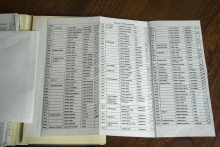This time, I’m going to share some thoughts on the Messier Catalogue. First published in 1774, Messier’s ‘Catalogue of Nebulae and Star Clusters’ initially included only 45 objects. Later editions brought the total to 103, with the final few (bringing the total to 110) added in 1966 following research into Messier’s notes.
These days, the Messier catalogue is the starting point for nearly all amateur astronomers. The list contains a wide variety of objects, some more challenging than others, with many being visible to the naked eye. Binoculars or a smallish telescope will reveal the majority. That the Messier catalogue is still the go to list for amateurs is testament to its variety, its challenges, and the fact that it’s just plain interesting. You’ve got open star clusters, globular clusters, supernova remnants, emission nebulae, galaxies … it’s really got everything you need to be getting on with.
Ticking off all the objects on the list can take several years. Because Messier was observing the night sky from further south than the UK, many of his objects are only visible for a few weeks during the Summer months, and are often low in the south. If you miss the opportunity one year, you’ll have to wait a whole year for another go. I’m currently on 98 of the 110, and will have to wait until next Spring for the chance to tick off the remaining ones.
The Messier catalogue is not without its ‘quirks’. The title and the contents of the list itself are straightforward enough, but somehow Messier decided that the main purpose of the catalogue should be to list those objects that definitely weren’t comets, thus preventing frustration and confusion for comet hunters (comets were all the rage at the time).
If we accept Messier’s aim, then we have to ask why the Pleiades (M45), for example, are on the list. This star cluster was known to people in ancient times, and is depicted in the Lascaux cave paintings whichare estimated to be 17,300 years old. The Pleiadesare a regular sight in the night sky, and surely there’s no way they could be confused with a comet. Likewise, the Andromeda galaxy (M31) is well known, very large, and a regular sight … again, hardly something you’d mistake for a comet.
If some of the items included in the catalogue are a puzzle, some of its omissions are also a mystery. The Perseus Double Cluster, for example, certainly ticks the same boxes, as it were, as the Pleiades, and yet it’s not on the list. The Beehive star cluster (M44) is on there, but the Hyades cluster isn’t … I can, sort of, understand M73 (an asterism) and M40 (a double star) being on there. To the naked eye they’re small and faint, and rather hard to identify, and could, possibly, be confused as comets, but the Orion Nebula (M42), or the Lagoon Nebula (M8)? I’m not so sure.
It’s known that Messier (with the help of his assistant Pierre Méchain) was keen that the catalogue would be the most comprehensive of the time, and is known to have included some of the more obvious objects at the last minute prior to publication, just to bump up the numbers.
Although it is an odd list, and the rationale for inclusion or omission a little ‘erratic’, there’s no doubt that the Messier catalogue is probably the best place to start with astronomy. As I said earlier, the variety and challenges are such that it keeps your interest. Most astronomers, myself included, will regularly revisit Messier objects.
There are lots of good books available that’ll help you locate many of the Messiers (probably the best being ‘Turn Left at Orion’ by Guy Consolmagno), and smartphone/tablet apps like Google Sky Map, Stellarium and Star Walk will give a real-time display of the night sky, with Messier objects indicated.
What’s up?
As we’re now swinging into Autumn, this is probably the last opportunity this year to see such objects as the Lagoon, Omega, Trifid and Eagle Nebulae. Early in September, and from about 10PM they’ll be visible low in the south, in the Milky Way (a pair of binoculars will help). Look for M8, M17, M20 and M16, respectively using Google Sky Map, or similar.
From about 10.30PM, depending on where you’re observing from, look to the east. You should see the Pleiades rising. This unmistakeable star cluster is a delight in binoculars … and definitely isn’t a comet!
Clear skies!
Kevin Quinn is an amateur astronomer based in Cerne Abbas, he is the proud owner of a ten-inch reflector and a hefty pair of binoculars. He tweets via @CerneAstro, blogs via theastroguy.wordpress.com, and his book ‘Demystifying Astronomy – A beginner’s guide to telescopes, eyepieces and accessories for visual astronomy’ is widely available.
©Kevin Quinn







